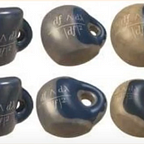To make a group from scratch, I need to start with a set of symbols.
I want to make my own set, so I picked 3 random symbols Ε, Ο, Δ to form set, and I will call this set G.
Notice that there is nothing special in the choices I made. You could have picked an apple, a banana, and a cherry for your set.
Rule 1: Closure
Now, if we just leave the set as how it is, it will be pretty boring set because there’s nothing we can learn from it. To make this set more interesting, I want to define a composition law ● on my set, so that any 2 symbols composed by ● will give another symbol in the set. We will name this quality “closure”.
For example, if I take E, and compose it with Ο (written as E ● O), I should get another symbol in the set (can be either E, O or Δ), but it can’t be a symbol outside of the set, and it can’t be nothing.
Now, I am ready to start composing symbols. To make my work more organized, I made a table to arrange the results of all possible compositions of these symbols, which looks like this:
I can be lazy, and have the results of all compositions be equal to the same symbol. Then I will have 3 tables that look like these:
Or I can just randomly stick in any symbol I want, and make tables that look like these:
How many of such tables can I make in total? For a set of 3 symbols only, there can be 3⁶ = 729 different tables, which is already a lot, considering that we might want to make a bigger set later on.
Rule 2: Identity
Now, to make some of these compositions more special than others, I want to make more rules on my set. I want to make one symbol as the “identity” symbol, so that any symbol composed with the identity will give itself back again.
In other words, if I pick E to be the identity, I will have the following relations:
Note that the relations are still true if I exchange the order of the 2 symbols composed by ● . Now let’s use a table to record our results so far:
Rule 3: Inverse
The next rule I want to make is that all symbols in my set will have an “inverse”. In other words, they all have to compose with something to give the identity E back again.
For the first relation, notice that I could only have 2 possibilities: 1) Ο ● Δ = E, or 2) Ο ● Ο = E, if the identity rule is supposed to hold true.
Let’s first investigate 1) Ο ● Δ = E. If this is true, then Δ will be the only answer for Ο ● Ο, because both Ο ● Ο = O and Ο ● Ο = E will lead to O = E, but we wanted all three symbols to be different.
Similarly, looking at the second relation Δ ● ? = E, if Ο ● Δ = E, then we cannot have Δ ● Δ = E without making Δ = Ο. As a result, Δ ● Ο = E, and it follows that Δ ● Δ = Ο. Putting these results into a table, we get:
Going back to our initial conjectures, we can also investigate the relation 2) Ο ● Ο = E and attempt to compose another table through a similar process, but this will eventually lead to inconsistencies with certain rules (for example, deriving both Δ ● Δ = E and Δ ● Δ = Δ) , so this will not work (try it yourself).
So now we have successfully eliminated the initial 728 possibilities of composing 3 symbols, and is left with only one. The table is called a group composition table, and the set of symbols with ● defined on them is called a group. Any group (G, ●) obeys the following axioms:
For any symbol a, b, c in the group G:
1). Closure: a ● b ∈ G.
2). Associativity: a ● (b ● c) = (a ● b) ● c.
3). Identity: There is an e in G such that e ● a = a = a ● e.
4). Inverse: There is a unique a′ for every a such that a′ ● a = e = a ● a′.
This concludes our short discussion of the motivations behind group theory.
